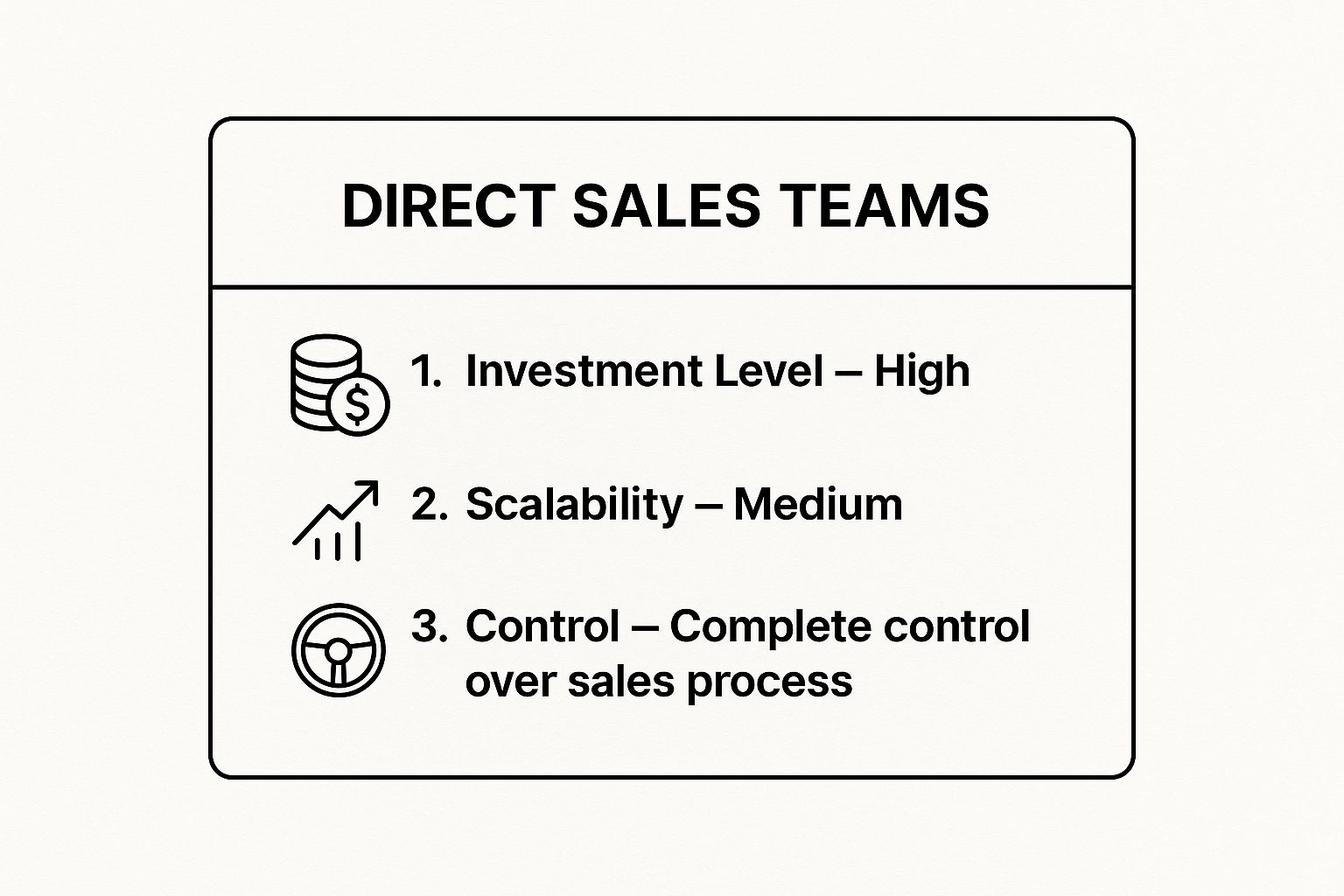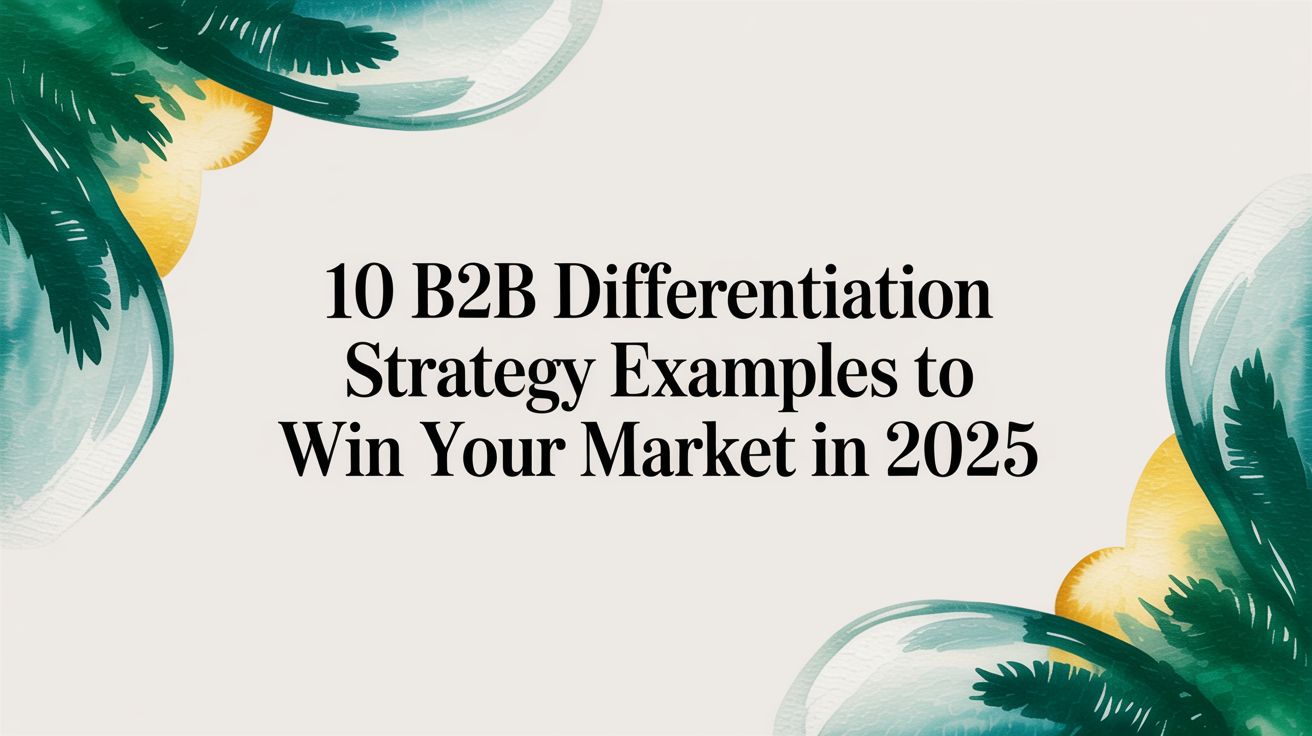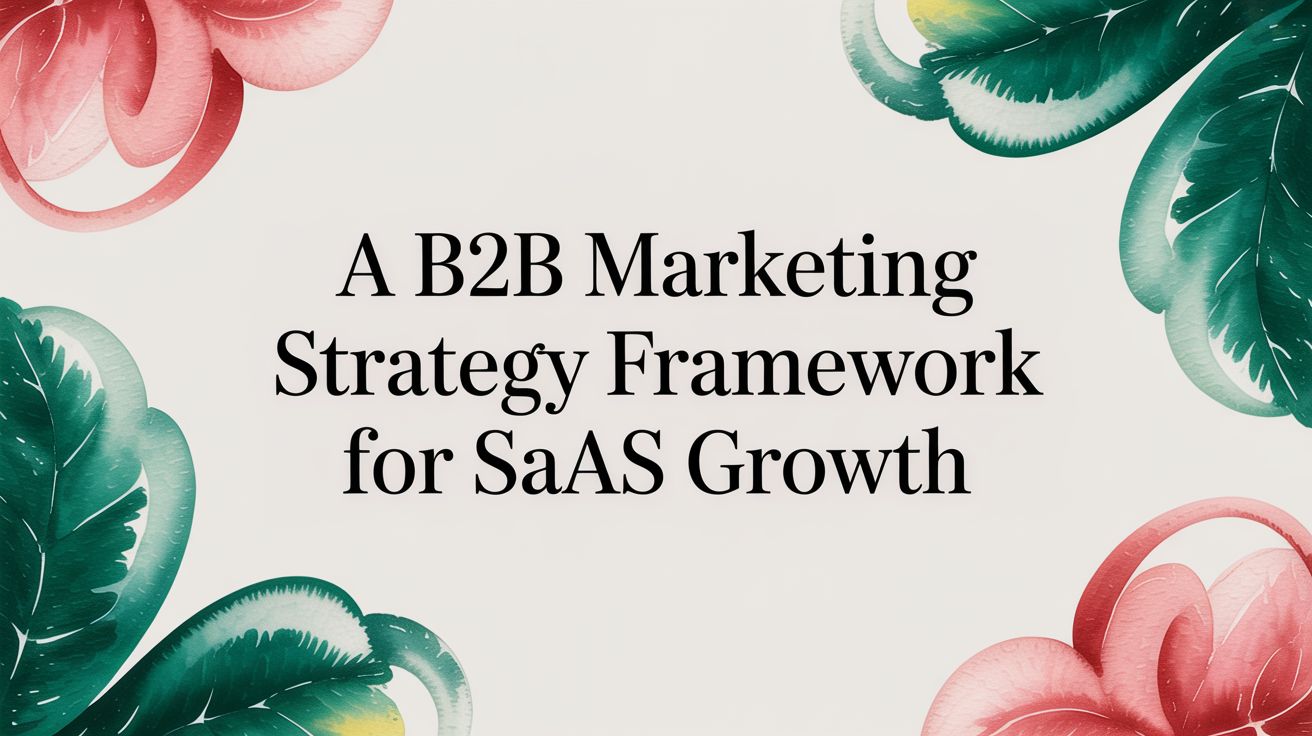9 Essential B2B Channels to Drive Growth in 2025
July 24, 2025

In the complex B2B landscape, choosing the right growth path is more critical than ever. It's not about being everywhere; it's about being in the right places, at the right time, with the right message. The term 'B2B channels' often gets thrown around, but the real power lies in understanding the nuances of each one, from the high-touch power of a direct sales force to the scalable reach of digital ecosystems.
This isn't just another list; it's a strategic blueprint designed to inspire your next big move. To truly chart a comprehensive B2B growth course, it's essential to understand modern strategies for every stage, from awareness to conversion. For a deeper dive into this journey, exploring the B2B Lead Generation Funnel for 2025 provides a valuable framework.
Here, we'll explore 9 pivotal B2B channels, dissecting their unique strengths, potential pitfalls, and the actionable steps you can take to integrate them into a cohesive growth engine. For B2B SaaS and tech founders, navigating this terrain can feel daunting, but with a clear understanding of your options, you can build a multi-channel strategy that not only generates leads but also builds a lasting competitive advantage. Let's unlock the channels that will propel your business forward.
1. Direct Sales Teams: The High-Touch Powerhouse
In the world of B2B channels, the direct sales team remains a formidable force. This model involves building an in-house team of sales representatives who engage directly with prospects to guide them through complex buying journeys. It’s the ultimate high-touch approach, enabling you to maintain complete control over your brand's narrative and the customer experience from start to finish.
This channel is indispensable for companies with high-value, nuanced solutions that demand consultative selling. Think of industry giants like Salesforce and Oracle, whose enterprise teams build deep, long-term relationships with large corporations, acting as strategic partners rather than just vendors. This direct interaction is a goldmine for market feedback, providing unfiltered insights straight from your target audience.
Keys to a High-Performing Sales Team
Building a powerhouse sales team requires more than just hiring good talkers; it's about engineering a system for success.
- Invest in Elite Training: Your reps are extensions of your brand. Equip them with deep product knowledge, industry expertise, and sophisticated sales methodologies through continuous, rigorous training programs.
- Arm Them with Technology: Implement a robust CRM like HubSpot or Salesforce to manage pipelines, track interactions, and automate administrative tasks. This frees up your team to focus on what they do best: selling.
- Define the Playbook: Create crystal-clear sales processes and playbooks that outline everything from qualifying leads to handling objections and closing deals. This ensures consistency and scalability.
Key Insight: A direct sales team isn't just a channel; it's a strategic asset. By investing in your people, you're building a direct line to your customers that fosters unparalleled loyalty and delivers invaluable market intelligence.
For a quick reference on this channel's strategic considerations, here’s a summary of its core attributes.

The visualization highlights a critical trade-off: achieving complete control over your sales process requires a significant investment, but it provides a powerful, if moderately scalable, path to market leadership.
2. Channel Partners/Resellers: The Force Multipliers
When you need to scale your market presence rapidly, leveraging channel partners and resellers is one of the most powerful B2B channels available. This model involves collaborating with third-party companies that sell your product for you, using their established customer base and market credibility to extend your reach exponentially. It’s a symbiotic relationship where partners gain a valuable new offering, and you gain access to new markets without the massive overhead of building a direct sales force from scratch.
This strategy is a cornerstone for tech giants like Microsoft and Cisco, whose vast partner networks are critical to their global dominance. Similarly, HubSpot’s agency partner program empowers marketing agencies to sell and service its software, creating a win-win that drives widespread adoption. By tapping into a partner’s existing trust and relationships, you can dramatically shorten sales cycles and penetrate markets that would otherwise be difficult to reach.
How to Build a Thriving Partner Ecosystem
A successful partner program is built on mutual trust, clear incentives, and robust support. It’s about empowering others to sell as effectively as you do.
- Develop Comprehensive Onboarding: Create a structured training program that equips partners with deep product knowledge, ideal customer profiles, and your brand's core value proposition.
- Provide Co-Branded Marketing Assets: Arm your partners with professional, co-branded marketing materials, sales decks, and case studies. This ensures brand consistency and makes it easy for them to start selling.
- Establish Clear Rules of Engagement: Define territories, lead registration processes, and commission structures in a clear partner agreement to prevent channel conflict and ensure fairness.
Key Insight: A channel partner program isn't just a sales tactic; it's an ecosystem. By investing in your partners' success, you transform them into dedicated advocates for your brand, creating a powerful and scalable engine for growth.
For those looking to dive deeper into structuring these relationships, you can learn more about building a successful channel marketing strategy on bigmoves.marketing. This approach allows you to multiply your sales efforts and achieve a level of market coverage that would be nearly impossible alone.
3. Digital Marketing & Content Marketing: The Authority Engine
In the modern B2B landscape, digital and content marketing have become the gravitational center for customer acquisition. This approach flips the traditional sales model on its head, focusing on attracting prospects by providing immense value upfront through content, SEO, and targeted digital campaigns. It's about building trust and establishing your brand as an industry authority, so customers come to you.
This inbound-focused model is the engine behind many of today's fastest-growing B2B companies. Think of HubSpot, which literally wrote the book on inbound marketing, using its blog, educational resources, and free tools to create a massive lead generation machine. Similarly, Drift pioneered conversational marketing, using its own platform and content to dominate a new category. These companies don't just sell; they educate and empower their audience.

Keys to a High-Performing Inbound Engine
Building a powerful inbound presence requires a strategic, multi-faceted approach that integrates content with smart distribution.
- Create Persona-Specific Content: Develop content that directly addresses the pain points of your ideal buyer at every stage of their journey, from awareness to decision. A powerful component of the inbound engine, implementing proven webinar marketing strategies can significantly drive engagement and qualified leads.
- Master SEO and Distribution: Your content is only valuable if it gets found. Optimize everything for search engines using industry-specific keywords and promote it across relevant channels like LinkedIn, email newsletters, and online communities.
- Leverage Marketing Automation: Use platforms like Mailchimp or HubSpot to nurture leads with automated email sequences, segment audiences, and score leads based on engagement. This ensures no potential customer falls through the cracks. Learn more about how to build a powerful B2B content marketing strategy.
Key Insight: Digital and content marketing are not just lead generation tactics; they are assets that build compounding value. Every article, case study, and video you create is a digital salesperson working for you 24/7, solidifying your brand's authority and creating a moat around your business.
4. Trade Shows & Industry Events: The In-Person Connection Engine
In an increasingly digital world, the power of face-to-face interaction remains one of the most impactful B2B channels available. Trade shows and industry events bring your target audience together in one place, offering a unique opportunity to showcase products, forge partnerships, and build relationships with a personal touch that digital channels often lack. It’s where handshakes lead to deals and live demos create lasting impressions.
Think of Salesforce at its own Dreamforce conference, a spectacle that has become a destination event for the entire industry. Similarly, tech companies flock to CES to unveil B2B innovations, and fintech leaders converge at Money20/20 to shape the future of finance. These events are powerful platforms for generating high-intent leads and cementing your brand’s authority in the market. A well-executed event presence can fill your sales pipeline for months.

Keys to a Winning Event Strategy
Maximizing your return from trade shows requires meticulous planning and flawless execution, turning a costly expense into a high-yield investment.
- Set Crystal-Clear Objectives: Before booking your booth, define what success looks like. Is it 100 qualified leads, 10 scheduled C-suite meetings, or a specific amount of pipeline generated? Track these metrics rigorously.
- Engineer an Engaging Experience: Ditch the boring static display. Create an interactive booth with live demos, hands-on product stations, or compelling presentations that draw attendees in and clearly communicate your value.
- Master the Follow-Up: The real work begins after the event. Have a system ready to follow up with every lead within 48 hours. A prompt, personalized follow-up is critical to converting conversations into customers. You can Learn more about how events fit into a B2B marketing channel strategy on bigmoves.marketing.
Key Insight: Trade shows aren't just about lead generation; they are about presence and perception. By creating a memorable experience, you build brand equity and demonstrate market leadership in a way that resonates long after the event concludes.
5. Referral Programs: The Engine of Trust-Based Growth
Referral programs are one of the most powerful and authentic B2B channels, transforming your satisfied customers, partners, and employees into a proactive extension of your sales force. This systematic approach incentivizes your network to recommend your business, leveraging the unparalleled power of word-of-mouth marketing. It’s a strategy built on trust, as a recommendation from a known source carries far more weight than a traditional advertisement.
This channel excels at acquiring high-quality leads that often close faster and have a higher lifetime value. Consider how Dropbox used a simple, dual-sided referral program (offering extra storage to both the referrer and the new user) to achieve exponential growth. Similarly, Slack offers credits for workspace upgrades, turning happy teams into evangelists. These programs tap into an existing base of goodwill, creating a self-perpetuating cycle of growth fueled by genuine advocacy.
Keys to an Irresistible Referral Program
A successful referral program feels less like a transaction and more like a shared win. Engineering this experience requires careful design.
- Make It Effortless: The referral process must be incredibly simple. Provide a unique, shareable link or a one-click button within your platform. The easier it is for someone to refer, the more likely they are to do it.
- Offer Compelling, Mutual Incentives: Reward both the referrer for their trust and the new customer for taking action. This could be a discount, a service credit, a gift card, or even early access to new features. A two-sided reward system creates a win-win scenario.
- Automate and Promote: Use referral marketing software like ReferralCandy or PartnerStack to automate tracking, attribution, and reward fulfillment. Regularly promote the program through email newsletters and in-app notifications to keep it top of mind.
Key Insight: A referral isn't just a lead; it's a testament to your value. By systematically encouraging and rewarding advocacy, you build one of the most cost-effective and high-converting B2B channels available, turning customer satisfaction into a scalable growth engine.
6. Inside Sales/Telemarketing: The Engine of Scalable Outreach
Inside sales has evolved far beyond traditional cold calling. It now represents a sophisticated, technology-driven approach where sales teams engage prospects remotely via phone, email, and video calls. This channel excels at high-volume, systematic outreach, making it a powerhouse for generating and converting leads without the cost and logistical challenges of face-to-face meetings. It’s one of the most efficient B2B channels for reaching a broad market segment.
This model is a cornerstone for many modern SaaS giants. Think of HubSpot and Salesforce, whose inside sales teams masterfully nurture leads through the funnel, particularly in the SMB market. Likewise, companies like ZoomInfo and Outreach.io not only provide the tools for inside sales but also use their own platforms to demonstrate its power, building massive pipelines through disciplined, multi-channel outreach campaigns. To continuously fuel this pipeline, exploring effective lead generation strategies is essential.
Keys to a High-Performing Inside Sales Engine
Building a successful inside sales function is about creating a repeatable and optimized process that consistently delivers results.
- Master the Multi-Touch Cadence: Don't rely on a single phone call. Develop compelling multi-touch sequences that combine calls, personalized emails, and social media interactions (like LinkedIn) to stay top-of-mind and build rapport.
- Invest in Quality Data and Tools: Your team's efficiency depends on the quality of their lead lists. Use data enrichment tools to ensure accuracy and a robust sales engagement platform to automate sequences and track performance.
- Coach for Conversational Excellence: Equip your team with strong scripts, objection-handling techniques, and ongoing coaching. The goal isn't just to pitch; it's to start meaningful conversations that uncover pain points and qualify opportunities. Learn more about optimizing your B2B sales process on bigmoves.marketing.
Key Insight: Inside sales is the ultimate blend of human touch and technological efficiency. By systematizing outreach and empowering your team with the right tools and training, you can build a scalable growth engine that consistently fills your pipeline.
7. Strategic Alliances & Joint Ventures: The Ultimate Force Multiplier
Beyond simple partnerships, strategic alliances and joint ventures represent a deep, formal commitment between two or more companies to achieve a shared objective. This B2B channel involves pooling resources, sharing risks, and co-developing solutions or go-to-market strategies to create value that neither party could achieve alone. It's about building a symbiotic relationship where 1+1 equals 3.
This powerful approach is a hallmark of technology giants that understand the value of an integrated ecosystem. Consider the alliance between Salesforce and AWS, which combines a world-class CRM with leading cloud infrastructure to deliver unparalleled value to enterprise customers. Similarly, Microsoft and Accenture's joint venture, Avanade, was created specifically to help clients leverage the Microsoft platform, demonstrating how alliances can become massive businesses in their own right.
Keys to a Successful Strategic Alliance
Forging a successful alliance requires meticulous planning and a commitment to mutual success. It’s a marriage, not a casual fling.
- Define Everything Upfront: Create a detailed charter that clearly outlines roles, responsibilities, financial arrangements, intellectual property rights, and success metrics. Ambiguity is the enemy of collaboration.
- Align on a Shared Vision: Ensure both organizations are completely aligned on the target market, ideal customer profile, and the joint value proposition. Without this, your go-to-market efforts will be disjointed.
- Establish a Joint Governance Model: Appoint an alliance manager from each side and set up regular communication cadences and executive reviews to steer the partnership, resolve conflicts, and track progress against KPIs.
Key Insight: A strategic alliance isn't just a sales tactic; it's a corporate strategy. It allows you to enter new markets, acquire new capabilities, and deliver more comprehensive solutions faster than you ever could on your own.
8. E-commerce & Online Marketplaces: The Digital Storefront Revolution
The B2B buying experience is rapidly mirroring B2C, and e-commerce platforms are at the forefront of this shift. This channel involves selling products directly to business customers through a dedicated online store or leveraging massive third-party marketplaces. It streamlines the procurement process, offering 24/7 access and empowering buyers with self-service capabilities that modern professionals now expect.
This approach is essential for businesses selling standardized products, from industrial supplies to software licenses. Look at Grainger, which transformed industrial supply with its powerful e-commerce platform, or Amazon Business, which brought the convenience of consumer online shopping to the corporate procurement world. These platforms demonstrate that even complex B2B transactions can be made efficient and user-friendly, expanding market reach far beyond traditional sales territories. This is one of the most scalable B2B channels available today.
Keys to a High-Converting B2B E-commerce Platform
Building an effective online sales channel for B2B requires more than a simple shopping cart; it demands a system tailored to business needs.
- Optimize for B2B-Specific Features: Implement functionalities like tiered or bulk pricing, customer-specific catalogs, and multi-user accounts with approval workflows. These features are non-negotiable for serious business buyers.
- Implement Robust Search and Filtering: Business customers need to find exact-match products quickly. Invest in advanced search with detailed filters for technical specifications, compatibility, and certifications.
- Provide Rich Product Information: Go beyond basic descriptions. Offer comprehensive spec sheets, CAD files, high-resolution images, and detailed use cases to give buyers the confidence to purchase without a sales call.
Key Insight: B2B e-commerce isn't about replacing sales teams; it's about augmenting them. By automating transactional sales, you free up your high-value sales experts to focus on strategic accounts and complex, solution-based selling.
9. Account-Based Marketing (ABM): The Laser-Focused Pursuit
Account-Based Marketing (ABM) flips the traditional marketing funnel on its head. Instead of casting a wide net, ABM is a highly strategic B2B channel where marketing and sales teams collaborate to target a curated list of high-value accounts. This approach treats individual accounts as markets of one, delivering hyper-personalized campaigns and bespoke buying experiences.
This channel is a game-changer for B2B companies with long sales cycles and high-value deals, where a one-size-fits-all message simply won't cut it. Pioneers like Terminus and Demandbase have championed ABM, using sophisticated platforms to identify, engage, and win over best-fit customers. By focusing resources on accounts with the highest revenue potential, ABM delivers unparalleled efficiency and ROI.
Keys to Winning with Account-Based Marketing
Launching a successful ABM strategy requires deep alignment and a commitment to personalization at scale. It’s about quality of engagement, not quantity of leads.
- Define and Score Your Targets: Develop a crystal-clear Ideal Customer Profile (ICP) and use it to build a target account list. Implement a scoring model based on firmographics, technographics, and intent data to prioritize your efforts.
- Invest in Account Intelligence: Arm your teams with tools like 6sense or Demandbase that provide deep insights into account behavior, buying signals, and key stakeholders. This data is the fuel for your personalization engine.
- Orchestrate Personalized Plays: Create account-specific content, tailored ad campaigns, and personalized outreach sequences. Ensure sales and marketing are perfectly aligned on the strategy and messaging for each target account.
Key Insight: ABM isn't just a marketing campaign; it's a fundamental business strategy. By uniting sales and marketing around the shared goal of winning specific accounts, you transform your go-to-market engine into a precise, high-impact revenue machine.
For those looking to deepen their understanding, you can learn more about how to maximize ROI with Account-Based Marketing and see how it fits into your broader strategy.
B2B Channel Strategies Comparison Matrix
Crafting Your Winning Channel Mix
The journey through the landscape of B2B channels, from the high-touch power of a direct sales team to the expansive reach of digital content, reveals a fundamental truth: there is no single magic bullet. The most resilient and rapidly scaling B2B organizations are not built on one pillar. They are constructed like a masterfully engineered symphony, where each channel plays a distinct, complementary part to create a powerful, cohesive go-to-market engine.
We've explored a dynamic roster of options, including the deep relationship-building of channel partners, the targeted precision of Account-Based Marketing (ABM), and the brand-building authority of industry events. Each one offers a unique pathway to your ideal customer. The key is not to choose one, but to architect a strategic, integrated mix that generates compounding returns over time. Your secret weapon is synergy, where your content marketing fuels your inside sales team, and your strategic alliances open doors for your direct sales force.
Charting Your Course: From Strategy to Execution
So, where do you begin? The path forward is paved with focused action and intelligent iteration. Avoid the temptation to do everything at once. Instead, build your channel strategy with the precision of a seasoned architect, focusing on a foundation that aligns perfectly with your current reality.
- Assess Your Foundation: Revisit your core business metrics. What is your average contract value (ACV)? How complex is your product's sales cycle? Who, precisely, is your ideal customer profile (ICP)? A high-ACV, complex enterprise solution will demand a different channel mix than a low-touch, high-volume SaaS product.
- Start Lean, Then Layer: Begin with a focused duo or trio of B2B channels that offer the most direct path to your first customers. A common and powerful starting point for tech startups is combining the lead-generation magnet of content marketing with the proactive outreach of an inside sales team.
- Pilot, Measure, and Validate: Before pouring your entire budget into a channel, run a pilot program. Define clear key performance indicators (KPIs), establish a timeline, and rigorously measure the results. Did your trade show appearance generate qualified leads? Did your referral program produce new customers with a low acquisition cost? Use this data, not assumptions, to decide whether to scale, pivot, or abandon a channel.
- Embrace Dynamic Integration: The true power of your strategy will emerge when your B2B channels work together. Your event marketing should feed your email nurture sequences. Insights from your direct sales team should inform your content strategy. This interconnected approach creates a seamless customer journey and amplifies the impact of every marketing dollar spent.
Building a winning channel mix is an ongoing process of discovery, testing, and optimization. It’s a journey that demands strategic foresight and a relentless focus on execution. The right combination of B2B channels will not just find you customers; it will build a sustainable, scalable engine for growth that becomes your ultimate competitive advantage. The roadmap is in your hands. Now is the time to execute with confidence and build the future of your business.
Navigating the complexity of building the perfect channel mix can be daunting, especially when resources are tight. If you're looking for expert guidance to develop a data-driven go-to-market strategy and ensure your investments in B2B channels lead to measurable growth, the fractional CMOs at Big Moves Marketing are here to help. Explore how we can build your roadmap to scale at Big Moves Marketing.
%20-%20Alternate.svg)


%20-%20white.svg)